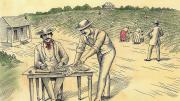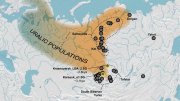Innovation drives American business—but not always for the common good. In Accounting for Slavery, historian Caitlin C. Rosenthal, Ph.D. ’12, finds innovation paired with racialized violence in the antebellum slave economy.
When Rosenthal started her doctoral studies, she didn’t expect to write about slavery. Three years as a consultant at McKinsey & Company had attuned her to “the ways scale changes how CEOs relate to workers, how managers think about labor.” This interest first led her to research “iron forges and textile mills” in the North’s industrial cities.
Her focus moved southward when visiting professor Stanley L. Engerman of the University of Rochester, a quantitative economic historian and pioneer in studying the economics of slavery, gave her a copy of Thomas Affleck’s Cotton Plantation Record and Account Book, published annually between 1848 and 1860. A standardized journal kept by plantation owners, the Account Book tracked metrics like slave productivity. From this interaction was born Accounting for Slavery, just published by Harvard University Press, in which Rosenthal examines such records to understand slaveholders’ management and accounting techniques. “The goal of the project,” which began with her dissertation, she says, “was to write slavery back into the history of American business.”
Slavery is often understood as an impediment to the development of American capitalism—a failure of both morals and business. From this mindset, Rosenthal explains, “it is possible to craft a really triumphant narrative of American business,” in which economic freedom and human rights advance together.
Plantation account books, she argues, undermine this narrative of mutual progress. Instead, they demonstrate that plantation owners employed innovative management techniques, from multidivisional organizational structures and standardization (like the use of identical records that “could be compared across multiple plantations and over time”) to depreciation and nascent forms of scientific management, whereby workers are thought of as “inputs of production” and tracked meticulously to increase productivity. The control and consistency of an enslaved workforce facilitated these innovations, allowing managers to keep careful records and experiment freely—even as hints of escape or resistance in the account books demonstrate enslaved people’s efforts to subvert that control. As Rosenthal writes, “Systematic accounting practices,” like maintaining records of individual productivity, “thrived on antebellum plantations—not despite the chattel principle, but because of it.”
Drawing on Rosenthal’s interdisciplinary background in labor and business history as well as economics, Accounting for Slavery has what the author calls an “eclectic setup.” Rather than delving into a single geography and moment in time, as an historian might, Rosenthal organizes chapters by specific “innovations of business history, like the development of organizational hierarchies.” She tracks these innovations on plantations throughout the nineteenth-century West Indies and the American South, drawing parallels to the nineteenth-century North and modern economy. She finds her sources in archives from Britain and Barbados to Harvard’s Baker Library (and even Engerman’s basement, where he keeps original records acquired through decades of research). In a choice reminiscent of business journals, she focuses on “exceptional cases”: the largest and most productive plantations, or those that kept the most diligent records.
This choice also reflects broader dilemmas in archival research. Often (though not always), a source’s survival indicates the wealth, power, or foresight of someone who owned it. In England, for example, Rosenthal found decades’ worth of pristine, preserved annual reports sent from Caribbean managers to absentee plantation owners across the Atlantic. In the West Indies, by contrast, she often located mere “scraps” of corresponding day-to-day records lost to humidity and the relative lack of resources for preservation.
Despite this survivor bias, she suggests that the obsession with record-keeping and productivity-tracking extended down the management hierarchies on plantations throughout the slave economy. Discussing the work of using records that survived in England to study plantations in the West Indies, for example, Rosenthal reflects, “You look back from the available records that survived in England to ascertain what system they lay on top of.”
In doing so, she hopes to bridge current debates in the history of slavery. Historians and economists, for example, have long disputed the cause of a mid-nineteenth-century spike in Southern productivity. Economists argue for agricultural innovations, such as new cotton seeds, while historians contend that greater levels of violence drove heightened production. Plantation account books point to both answers: slaveholders, Rosenthal writes, “pursued multiple strategies in combination, weaving agricultural innovation and coercion together in strategies to grow more cotton.”
These innovations, she insists, should not be celebrated. On the contrary, “the tone of the project is one of critique.” According to its author, Accounting for Slavery is “a cautionary tale about what capitalism can look like, and has looked like, when the rules allow capital almost unlimited control over labor.” Nor is this critique limited to the South: “We have grown used to separate conversations about the slave South and the North,” Rosenthal explains, “when really they were two settings in one connected economy, evolving together.” Slaveholders’ “business innovations were as central to the emerging capitalist system as those in free factories.”
Given this insight, a reader might ask how Americans should grapple with an economic system that thrived in the absence of human freedom. For Rosenthal, history suggests that regulation can help rein in the excesses of capitalism. The abolition of slavery, in her framing, was not just a moral triumph, but also a regulatory victory that limited planters’ economic freedoms in order to protect the rights of enslaved people. As Rosenthal, now an assistant professor of history at the University of California, Berkeley, reflects, “I hope that businesspeople will pick up my book and find inspiration for developing ethical practices, but that will never be enough. Protecting people from the extremes of profit-seeking will always require regulation.”
Rosenthal is optimistic that by heeding the history of slavery and innovation, Americans can “rethink the kinds of data we record and how we use it” in labor settings. In antebellum America, when sophisticated accounting practices upheld an economy dependent on racialized slavery, she finds innovation and violence behind the dry figures.









